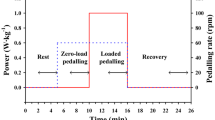Abstract.
The effects of using different algorithms to estimate the time constant of changes in oxygen uptake at the onset of square-wave 120 W cycloergometric exercise were evaluated in seven subjects. The volume of oxygen taken up at the alveoli (VO2Ai) was determined breath-by-breath (BB) from the volume of O2 transferred at the mouth (VO2mi) minus the corresponding volume changes in O2 stores in the alveoli: VO2Ai=VO2mi–[V Ai–1(FO2Ai–FO2Ai–1)+FO2Ai·ΔV Ai], where V Ai–1 is the alveolar volume at the end of the previous breath, FO2Ai and FO2Ai–1 are estimated from the fractions of end-tidal O2 in the current and previous breaths, respectively, and ΔV Ai is the change in volume during breath i. These quantities can be measured BB, with the exception of V Ai–1 which must be assumed. The respiratory cycle has been defined as the time elapsing between identical fractions of expiratory gas in two successive breaths. Using this approach, since FO2Ai=FO2Ai–1, any assumption regarding V Ai–1 becomes unnecessary. In the present study, VO2Ai was calculated firstly, by using this approach, and secondly by setting different V Ai–1 values (from 0 to FRC+0.5 l, where FRC is the functional residual capacity). Values for alveolar O2 flow (V˙O2Ai), as calculated from the quotient of VO2Ai divided by breath duration, were then fitted bi-exponentially. The time constant of the phase II kinetics of V˙O2Ai (τ2) was linearly related to V Ai–1, increasing from 36.6 s (V Ai–1=0) to 46.8 s (V Ai–1=FRC+0.5 l) while τ2 estimated using the first approach amounted to 34.3 s. We concluded that, firstly, the first approach allowed us to calculate V˙O2A during transitions in step exercise; and secondly, when using methods wherein V Ai–1 must be assumed, τ2 depended on V Ai–1.
Similar content being viewed by others
Author information
Authors and Affiliations
Additional information
Electronic Publication
Rights and permissions
About this article
Cite this article
Cautero, .M., Beltrami, .A., di Prampero, P.E. et al. Breath-by-breath alveolar oxygen transfer at the onset of step exercise in humans: methodological implications. Eur J Appl Physiol 88, 203–213 (2002). https://doi.org/10.1007/s00421-002-0671-8
Accepted:
Issue Date:
DOI: https://doi.org/10.1007/s00421-002-0671-8




